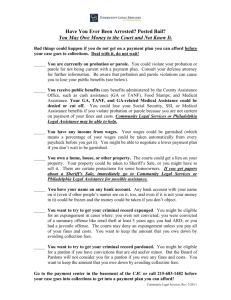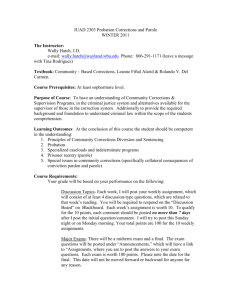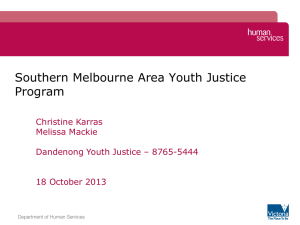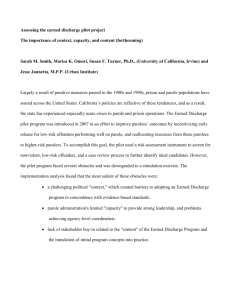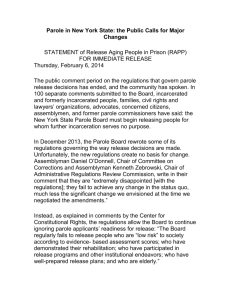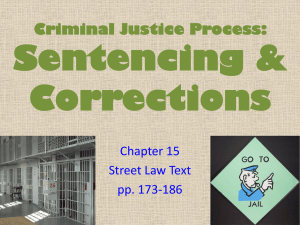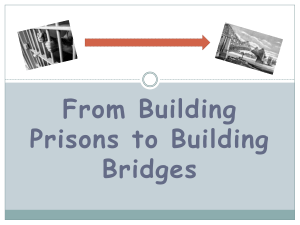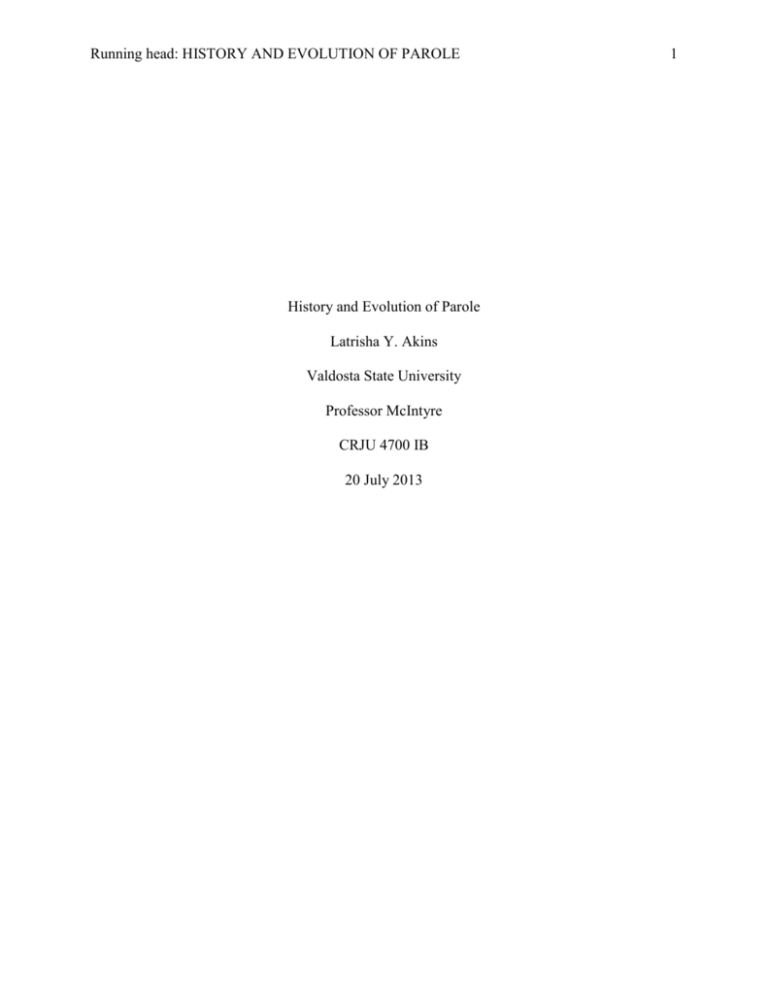
Running head: HISTORY AND EVOLUTION OF PAROLE
History and Evolution of Parole
Latrisha Y. Akins
Valdosta State University
Professor McIntyre
CRJU 4700 IB
20 July 2013
1
HISTORY AND EVOLUTION OF PAROLE
2
The origin of parole is accredited to the works of three individuals, they include: Alexander
Maconochie (1840), Walter Crofton (1854) and Zebulon Brockway (1876). Abadinsky (2012)
wrote that Maconochie, who was a superintendent of the British Penal colony on Norfolk Island,
philosophy was based on reforming the individual: the convict was to be punished for past and
trained for the future (p. 120). His establishment of a three stage system consisted of marks that
could be earned by inmates, contingent upon good behavior. Crofton, the director of the Irish
prison system, had similar views to that of Maconochie. His system included four stages, the
latter containing the “ticket of leave”. The ticket of leave allowed prisoners to be released under
supervision (Abadinsky, 2012, p.121). Brockway, superintendent of the Elmira Reformatory,
was influenced by Crofton’s Irish system. His system involved military-style uniforms, marching
and discipline, it was known as the Elmira system (America’s first parole system). Proceeding
Brockway, the system of indeterminate sentencing and parole was adopted. Indeterminate
sentencing allowed facilities to hold an inmate as long they could until it was believed that the
behavior of the offender had changed. As noted in Abadinsky (2012), by 1944, all 48 states had
enacted parole legislation (p. 123).
“Parole, comes from the French word parol refers to “word of honor” (Abadinsky, 2012,
p.119). Over time the meaning of parole has come to be defined as, “an inmate’s promise to
conduct him or herself in law-abiding manner and according to certain rules in exchange for
release” (Petersilia, 2000, p. 36). Carter & Wilkins (1970) stated that, “parole is a procedure by
which prisoners are selected for release and a service by which they are provided with necessary
controls, assistance and guidance as they serve the remainder of their sentences within the free
community” (p.180). Offenders are generally released under conditions, after having served a
portion of their sentence in a correctional facility. Parole is considered to be a privilege for
HISTORY AND EVOLUTION OF PAROLE
3
inmates who meet the requirements for eligibility. The aims of parole are to reduce the problems
of overcrowding (enabling them to make more room for those who wait), rehabilitate the
offender by encouraging good behavior in inmates and to supervise the convict after parole has
been granted. “Parole is a treatment program, in the interest of society and individual, whereas,
he is under supervision and treatment by a person trained in parole work” (Dressler, 1959, p.44.).
Parole serves many purposes: one of the purposes of parole is to give inmates an
opportunity to serve the remainder of their sentence in the community under supervision and to
“get used to” life outside of a correctional facility. “This supervision and support benefits the
wider community by reducing the risk that offenders will commit further offenses when released
into the community” (Department of Justice). The assistance obtained by parolees include
treatment programs, helping them find employment and/or residence and any other issues that
may arise while trying to adjust back into society. A second purpose of parole is to protect
society by helping the convicts get back established; thus preventing them from further
committing new crimes. This view point has seldom been claimed as “leniency” because of the
excess number of convicts who have returned back to prison. According to Carter & Wilkins
(1970) experts have indicated that, “prisoners serve as much time in confinement in jurisdictions
where parole is widely used as in those where it is not” (p.186).
Eligibility for an offender to be granted parole varies, depending upon the type of
sentence given to them by the court. If parole is granted, the earliest time an offender can be
paroled out is the date set for release or after the eligibility date. (USDOJ). Dressler (1959)
pointed out that, “some prisoners who are serving life terms will never be eligible for parole”
(p.62), in most cases these are for crimes such as capital felony, murder and first degree
HISTORY AND EVOLUTION OF PAROLE
4
aggravated sexual assault. However, these inmates may eventually come out by consent of a
governor or through serving their maximum sentence (Dressler, 1959, p. 62).
In most states, the decision of whether an inmate shall be granted parole is done by a
parole board. Dressler (1959) suggested that “in a few instances, paroles from city and county
institutions are granted by the court of convictions” (p.64). A parole board consists of
experienced people who are capable of making judgments regarding the release of an offender to
the return of an offender back to society. These members may include people such as judges or
even psychiatrists. In Probation and Parole, Abadinsky (2013) noted that “parole can be
administered independently or as part of a department that administers prisons, with or without
being combined with probation” because parole is administered centrally on a statewide basis (p.
145). Parole board members are generally appointed by the governor for six-term years by the
governor; many lacking relevant background or education (Abadinsky, 2013, p.148).
The Department of Justice defines parole hearing as an interview to determine whether or
not an inmate should be released from prison to parole supervision in the community. Parole
hearings are diverse. For adults, hearings are not guaranteed in all states; decisions are made
based on written reports. In some states, a panel of parole board members will interview eligible
inmates; in others, inmates are interviewed by a parole examiner who reports to the board with a
recommendation (Abadinsky, 2013, p.149). “Hearings give parole boards an opportunity to
identify important information needed in making their decision, it aims to create conditions to
enhance treatment goals for inmates and it allows parole boards to increase the involvement of
inmates in the decisions which affects them”(Carter & Wilkins, 1970, p.192).
Abadinsky (2013) quoted that parole release is considered as discretionary, and
therefore, an inmate has no liberty interest and no right to parole, he cannot lose anything, thus
HISTORY AND EVOLUTION OF PAROLE
5
due process at a parole release hearing is not required (p. 159). “The parole process begins when
the parole board sets the terms and conditions of the release date of the prison inmate” (Carter &
Wilkins, 1970, p.208). The inmate is responsible for the establishment of his parole program by
indicating his destination, work and resident plans. The plan is investigated by his parole officer
and if he is satisfied a Release Program Study is prepared. The agent has the right to deem the
program of the parolee as satisfied, denied or postponed. In the prerelease process, inmates’ main
concern is to be released and officials share that same interest for different reasons. In an attempt
to determine whether the prerelease task works, it is believed that “the combination of the
interests and concerns of the inmates, officials and parole agent that make these procedures
work” (Carter & Wilkins, 1970, p.214).
All parolees are required to sign an agreement to abide by regulations that are tailored to
them upon their release. Common standard parole conditions are: parolees must meet with their
assigned parole officer, obey all rules and regulations, report any changes in residence must not
own a firearm or commit any crimes, must not leave the state without consent of parole officer
and seek and maintain employment (Petersilia, 2000, p.43). The mission of parole is to protect
the citizens upon release of offenders back to society. Their goals includes identifying programs
that are best suited for the offender, establishing conditions of supervision that both control and
rehabilitate the offender, closely monitor offenders’ compliance with supervision and protect
victims by providing the necessary information swiftly.
Petersilia (2000) noted that “parole was founded to primarily foster offender reformation
rather than increase punitiveness or surveillance” (p.34). Although offenders are spending more
time in prison and are faced with tremendous amounts of difficulties obtaining success in the
outside world, seemingly crime has decreased but the prison population has increased.
HISTORY AND EVOLUTION OF PAROLE
6
According to Beck, “reality is that more than nine out of ten prisoners are released back into the
community and with an average U.S. prison term served of 15 month, half of all inmates in U.S.
prisons today will be back on the streets in less than two years” (1999). Studies show that over
the last two decades, the number of prisoners being released back into the community has
steadily increased. This must mean that parole has had some form of success since its adoption.
Imprisonment can cause psychological breakdowns, depression and mental illnesses,
which is another reason the focus is more on rehabilitation rather than punishment of an
offender. The foundation of rehabilitating the offender is based on treatment. Treatment involves
both time and skill. There are several ways to treat law-violators or any individual who signifies
unacceptable behavior but each personality is different, making it harder to accomplish the goal
of change. Carter and Wilkins (1970) concluded that “the objective, regardless of the approach,
is to create in a person self-acceptance which did not exist before” (p.289) thus making it a little
easier and more stable. In my opinion, there are still more improvements that can be made in
order to make parole a much more successful rendition, but it will require dedication, persistence
and motivation on the behalf of all parties involved.
HISTORY AND EVOLUTION OF PAROLE
7
References
Abadinsky, H. (2012). Probation and Parole: theory and practice (11th Ed.). Upper Saddle River,
New Jersey: Pearson Prentice Hall.
American Probation and Parole Association (1987, January). Parole. In 209 Position Statement.
Retrieved from http://www.appa-net.org/eweb/dynamicpage
Beck, Allen J. (1999). Trends in U.S. Correctional Populations. In The Dilemmas of Corrections.
(Eds). Kenneth Haas and Geoffrey Alpert. Prospect Heights, Illinois: Waveland Press, Inc.
Carter, R., & Wilkins, L. (Eds.). (1970). Probation and Parole: Selected Readings. New York,
London, Sydney, Toronto: John Wiley & Sons, Inc.
Department of Justice. Corrections Victoria. (2013). Parole. In Corrections, Prisons & Parole.
Retrieved from http://www.corrections.vic.gov.au/home/parole
Dressler, D. (1959). Practice and Theory of Probation and Parole. New York: Columbia
University Press
Petersilia, J. (2000). Parole and Prison Reentry in the United States, 1, 33-46. Retrieved from
http://www.appa-net.org
The United States Department of Justice. (N.D). In U.S. Parole Commission. Retrieved from
www.justice.gov

